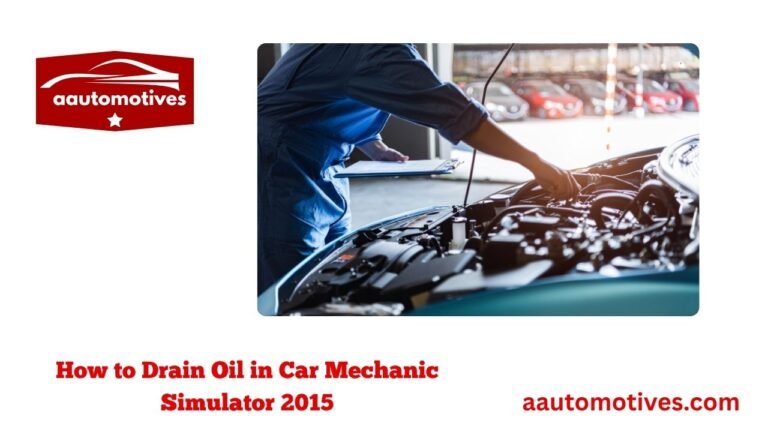Why Is Oil Leaking When Car Is Parked?

Ever stepped out for your morning coffee, only to spot a dark stain under your car? That sinking feeling hits hard. “Oh no, is my car bleeding?” you ask yourself. That’s not melodrama—it’s concern.
Seeing oil leaking when car is parked can feel like your car is trying to whisper something is wrong—but in its own oily language. And you’re not alone. It happens to many of us, often at the worst time. Whether it’s your driveway, garage, or a friend’s place (awkward), this little puddle can hint at big problems.
In this article, we’ll walk through why oil leaks when your car is parked, what it means, how to check it, and what to do next. It’s like car therapy—with a dash of grease.
In This Article
- 1 The Quick-Check: How to Confirm It’s Oil
- 2 Why Is Oil Leaking When Car Is Parked? Common Culprits Explained
- 3 Real Talk: My Own Experience With a Parked Oil Leak
- 4 The Risk Factor: Why You Shouldn’t Ignore That Leak
- 5 How to Diagnose the Leak Yourself (No Tools Needed)
- 6 When You Might Need a Mechanic
- 7 Fixing the Problem: What to Do When Oil Leaking When Car Is Parked
- 8 Prevention: Stop the Leak Before It Starts
- 9 When to Worry: Is It a Big Leak or a Little One?
- 10 FAQ: Answers to Your Top Questions About Oil Leaks
- 10.1 1. Can I drive my car if it’s leaking oil while parked?
- 10.2 2. How much does it cost to fix an oil leak?
- 10.3 3. Is it dangerous to have an oil leak?
- 10.4 4. Why does my car leak oil only when parked?
- 10.5 5. What should I do if I see fresh oil on the ground?
- 10.6 6. Is there a quick fix for small oil leaks?
- 10.7 7. Can extreme weather cause oil leaks?
- 10.8 8. Can I fix a leaking oil pan at home?
- 11 Final Thoughts: Embrace the Oil, but Fix the Drip
The Quick-Check: How to Confirm It’s Oil

-
Color: Engine oil is amber when fresh, dark brown or black when old.
-
Texture: Slick, smooth, and greasy.
-
Smell: Slightly burnt or chemical.
-
Location: Under the engine bay—middle front of the car.
If it’s reddish, it might be transmission fluid. Green or orange? Could be coolant. But if it’s thick, dark, and slick, it’s likely engine oil.
Why Is Oil Leaking When Car Is Parked? Common Culprits Explained
Cars don’t leak oil for no reason. Here are the usual suspects behind this annoying issue.
1. Worn Out Gaskets or Seals
Think of gaskets and seals like the zippers and buttons on clothes. They keep things together and sealed. Over time, they wear out.
-
Valve cover gasket: A common leak point, especially in older cars.
-
Oil pan gasket: Found underneath the engine. Constant heat and age weaken it.
-
Rear main seal: Leaks here are serious and hard to spot without inspection.
When your engine cools down after a drive, parts contract. If seals are old, they shrink and let oil seep out. That’s why it seems like the car leaks oil only when parked.
2. Loose or Damaged Oil Drain Plug
Every oil change involves removing the drain plug. If a mechanic (or you!) over-tightened or cross-threaded it, you’re inviting leaks.
Signs to look for:
-
Drops near the middle or rear end of the engine.
-
Recent oil change? It could be the plug or washer.
Tip: Replacing the plug or washer costs a few bucks—not a big fix.
3. Cracked Oil Pan
Imagine running over a rock or a nasty bump in the road. It might crack the oil pan. This is like your car’s oil bowl. Once cracked, it leaks whether the engine’s running or not.
It’s more common in low-suspension or sports cars, and especially in places with bad roads (hello, Dhaka’s potholes!).
4. Oil Filter Issues
Oil filters should be changed with every oil change. But sometimes:
-
It’s not tightened properly.
-
The old gasket is stuck and doubles up.
-
The filter itself is faulty.
This causes oil to drip slowly, especially after parking.
Real Talk: My Own Experience With a Parked Oil Leak
A few years ago, I was driving an older Honda Civic. It ran like a champ—until I started noticing spots on my garage floor. First small, then wider. I ignored it at first. Busy life, right?
But then came the smell. That burnt-oil scent after every trip. Eventually, I crawled underneath (with an old bedsheet and flashlight like a DIY mechanic). And there it was—a cracked valve cover gasket. A simple, cheap part causing big anxiety.
Fixing it took an afternoon and less than $50 in parts. But the lesson? Never ignore oil leaking when car is parked. Small leaks become big repairs.
The Risk Factor: Why You Shouldn’t Ignore That Leak
You might think, “It’s just a few drops.” But here’s what could go wrong:
| Issue | Consequence |
|---|---|
| Low Oil Level | Engine overheating, wear, or failure |
| Slippery Surfaces | Hazards in your garage or driveway |
| Environmental Harm | Oil contaminates soil and water |
| Fire Risk | Leaks near hot components can ignite |
Oil leaks don’t fix themselves. If your car is leaking oil while parked, it’s already telling you something’s broken.
How to Diagnose the Leak Yourself (No Tools Needed)
Not everyone has a lift or garage, but you can still investigate a bit on your own. Here’s how:
-
Place a cardboard or newspaper under the car overnight.
-
Mark the location where oil drips appear.
-
Use your phone’s flashlight to check under the car the next morning.
-
Sniff around—burning oil smells are a red flag.
-
Check the oil level with the dipstick. Low? You’ve confirmed it.
Still unsure? Take pictures and visit your mechanic. A good photo of the leak can save you time and diagnostic fees.
When You Might Need a Mechanic
Let’s be honest: some jobs are just too tricky without proper tools. You should see a professional if:
-
The leak is near the rear main seal.
-
Your oil level keeps dropping despite top-ups.
-
You smell burning oil while driving.
-
There’s smoke under the hood.
Also, if your car is new and leaking, use that warranty. Don’t delay repairs.
Fixing the Problem: What to Do When Oil Leaking When Car Is Parked
Now that you’ve diagnosed where the leak might be coming from, it’s time to roll up those sleeves—literally or figuratively. Depending on the issue, some fixes are easy and cheap, while others might need a mechanic’s touch.
1. Replace the Faulty Gasket or Seal
If a gasket (like the valve cover or oil pan gasket) is worn or cracked, replacing it is usually affordable. Labor might take 1–2 hours, but the parts are cheap.
Cost estimate:
-
Valve cover gasket: $20–$50
-
Oil pan gasket: $40–$80
-
Labor: $80–$200 depending on your location
If the rear main seal is the problem, buckle up—it can run you $500+ because of the labor. It’s buried deep between the engine and transmission.
2. Fix or Replace the Oil Drain Plug
Sometimes all you need is:
-
A new crush washer (literally $1)
-
A properly tightened drain bolt
If the thread is stripped, you might need a rethreading kit or a new oil pan, but that’s rare. In most cases, this is a simple fix any mechanic can do in under 30 minutes.
3. Swap Out a Leaky Oil Filter
If it’s a faulty or improperly installed filter, just get a new one. Always:
-
Hand-tighten the new filter
-
Check that the old rubber gasket isn’t stuck to the block
And be sure to use the right filter model for your engine. A mismatch can cause tiny gaps that slowly drip oil.
4. Repair or Replace a Cracked Oil Pan
This is a little more intense. If the oil pan is cracked, your options are:
-
Welding the crack (if small)
-
Replacing the entire pan (common and safer)
Make sure to avoid this issue by watching out for speed bumps and rocky roads. A skid plate can help protect the pan if you drive in rough terrain often.
Prevention: Stop the Leak Before It Starts
As the old saying goes, “prevention is better than cure.” And that couldn’t be truer when it comes to oil leaks.
Here are some tips to help you keep things clean and dry under your car:
Regular Oil Changes (with Inspections)
Don’t just change the oil—inspect surrounding parts too:
-
Gaskets
-
Seals
-
Filter threads
-
Drain plug
A good mechanic will spot early signs of wear and tear during a routine change.
Avoid Bad Roads (and Big Bumps)
This may sound basic, but hitting rough roads or curbs can knock loose parts or crack the pan.
If you live in an area with rough roads, think about:
-
Installing a skid plate
-
Driving slower over bumps
-
Parking on level surfaces
Keep the Engine Bay Clean
Use a degreaser spray to clean around the engine. It’s easier to spot new leaks on a clean surface. Plus, grime buildup can actually degrade rubber seals over time.
Check Your Oil Level Weekly
Use your dipstick like a health monitor. If your car suddenly needs more oil than usual, it’s a red flag.
It takes less than 2 minutes, and it can save your engine.
When to Worry: Is It a Big Leak or a Little One?
Not all leaks are equal. Here’s how to know when to act fast:
| Leak Size | Severity | Action |
|---|---|---|
| Few drops overnight | Low | Monitor & inspect next service |
| Small puddle (coin-size) | Medium | Schedule mechanic visit soon |
| Large puddle (>5 inches) | High | Immediate attention needed |
| Oil light on dashboard | Emergency | Don’t drive – tow it! |
Driving with low oil can wreck your engine—it’s the lifeblood. Always treat the dashboard oil light like an emergency.
FAQ: Answers to Your Top Questions About Oil Leaks
Here are some real-world questions people ask when dealing with oil leaking when car is parked—and the answers that’ll help:
1. Can I drive my car if it’s leaking oil while parked?
If it’s a few drops and oil levels are stable, maybe. But it’s risky. Check your dipstick, and never drive if the oil light is on.
2. How much does it cost to fix an oil leak?
It depends. Minor leaks like a gasket or plug may cost $50–$150. Major leaks (rear main seal) can exceed $500–$1000 due to labor.
3. Is it dangerous to have an oil leak?
Yes. Oil near hot engine parts can cause smoke or fire, and running low on oil can kill your engine.
4. Why does my car leak oil only when parked?
When the engine cools, metal parts contract, creating gaps where worn gaskets or seals might drip. It’s common in older cars.
5. What should I do if I see fresh oil on the ground?
First, confirm it’s oil. Check the dipstick, look under the car with a flashlight, and don’t ignore it. Early repairs are cheaper.
6. Is there a quick fix for small oil leaks?
Sealant products exist, but they’re temporary. They may stop minor leaks for a while but won’t replace a bad gasket or seal.
7. Can extreme weather cause oil leaks?
Yes. Cold weather makes rubber seals shrink. Heat can expand metal parts. The stress causes old seals to fail more easily.
8. Can I fix a leaking oil pan at home?
If you’re handy, have tools, and the crack is visible, yes. Otherwise, it’s best to get help—improper fixes can make leaks worse.
Final Thoughts: Embrace the Oil, but Fix the Drip
Seeing oil leaking when car is parked is a gut punch. It’s easy to ignore. Life’s busy. Money’s tight. But leaks don’t go away—they grow, slowly draining your engine and your wallet.
The good news? Most oil leaks start small. If caught early, they’re manageable. With a little attention, a flashlight, and maybe a cardboard box, you can spot the problem before it gets ugly.
Your car is talking to you—not with words, but with stains. Don’t ignore them.






